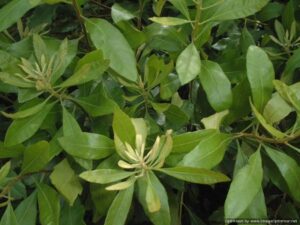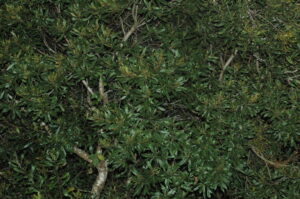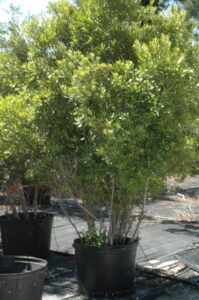S & J Nursery’s Guide to Growing
Wax Myrtle Trees
in the Northeast Florida Landscape
Wax Myrtle (Morella cerifera)  Origins:
Origins:
– Florida Native shrub or small tree
Wax Myrtle Preferred Exposure:
– The Florida Wax myrtle will grow in full sun or in shade.
– If planning on keeping this plant pruned into a hedge row planting in full sun is recommended as the plant will tend to thin out at the base tending to grow into more of a tree form when grown in the shade.
Wax Myrtle (Morella Cerifera) Foliage | Bark:
– Evergreen foliage of the Wax Myrtle tree is strongly fragrant when crushed and can be used as a substitute for the much harder to find bay leaves when cooking.
– Bark of the native Wax Myrtle tree is a dark grey spotted with lenticels when young and a mottled gray and white when aged.
Wax Myrtle Soil Preference / Salt tolerance:
– Wax myrtles tend to prefer moist sandy soils but are highly adaptable to a wide range of soil conditions.
– Perhaps only second to its ability to provide shelter for birds on the list of Wax Myrtle virtues is the salt tolerance of these shrubs or small trees. They make an ideal patio tree, hedge row or small scale ornamental tree for coastal landscapes in the North Florida | Jacksonville | St. Augustine area.
 Wax Myrtle Size Variance:
Wax Myrtle Size Variance:
– Most often seen at heights of 10-15 feet High | 6-10 feet wide, although they have been known to reach considerably higher in moist sandy wooded areas.
Wax Myrtle Growth Habit:
– Multi trunked habit forming a rounded head if left to grow naturally as a small landscape ornamental or patio tree.
Wax Myrtle Growth Rate:
– Wax Myrtles grow extremely fast and commonly add 2-3 feet in height each growing season when young.
Wax Myrtle Bloom:
– Smaller clusters of white blooms in summer held close to the branches and stems tend to be inconspicuous. The berry clusters that follow are a prized food source for overwintering birds in the North Florida | Jacksonville | St. Augustine area landscape.
Wax Myrtle Water Requirements:
– Although Was Myrtles will be found growing naturally in moist sandy soils, they can be quite drought tolerant once established in the landscape.
Butterfly or Bird Attracting:
– According to the University of Florida’s IFAS, Wax Myrtle trees are an important part of the winter diet for a surprising number of birds including wild turkeys, bob white quail, waterfowl, catbird, thrasher, bluebirds, vireos, and warblers and are the main food source for wintering tree swallows here in the Florida landscape.
– Not only do they provide a great reliable winter food source for birds, but
the dense foliage characteristic of the plant make an ideal habitat for nesting local birds as well as resting migrants.
– The leaves are a larval food source of the red banded hair streak
butterfly.
Best Uses For Wax Myrtles:
– Wax Myrtle trees are without a doubt a necessity for local birders and wildlife lovers alike.
– They make an ideal patio tree or small scale ornamental tree in sun or shade and will make an excellent privacy hedge when clipped and maintained in a full sun location.
Care of Wax Myrtles:
– Water every day during the establishment period. See watering your newly planted trees for more information.
– Prune in March or April and again in summer and fall as needed to maintain a Wax Myrtle Hedge. Be careful not to remove more than 1/3 of the growth at any given time and avoid pruning into sticky non foliated leaf areas as recovery will be slow if at all if pruned to deeply.
– Prune out suckers and unwanted growth each spring when young to allow selected branches to form a multi trunk patio tree when used as a small scale landscape specimen.
– Provide a 1 ft diameter circle of mulched area where grass is kept from growing for each inch of caliper (or diameter) of trunk measured 4 inches from the ground level.
– Fertilize each spring with a mixture of Milorganite or “Green Edge” and a slow release poly coated plant food such as Osmocote or Stay Green general purpose plant food, sprinkling the fertilizer around the mulch circle underneath the foliage of the tree

